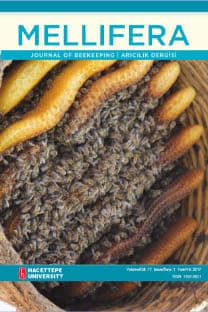Screening alternative antibiotics against Paenibacillus larvae subsp. larvae strains isolated from the different regions of Turkey
Bu çalışmada, Türkiye’nin farklı bölgelerinden izole edilen Paenibacillus larvae larvae’nin farklı suşlarının, 6 adet antibiyotiğe karşı duyarlılığını araştırılmıştır. Elde edilen sonuçlar duyarlıklık düzeyinin çeşitlilik gösterdiğini göstermiştir. En az aktivite gösteren antibiyotikler, azithromisin ve tobramisin olmuştur. Eritromisin orta derecede etkili bir antibiyotik olarak tanımlanmıştır. Rifampin, amoksisilin klavunolik asit ve sülbaktam ampisillin ise en etkili antibiyotikler olarak saptanmıştır. Ancak, rifampin tüberküloz hastalığına karşı kullanıldığından, bu bileşiğin tarımsal alanda kullanılması uygun değildir
Türkiye'nin farklı bölgelerinden izole edilen P.larvae larvae suşlarına karşı alternatif antibiyotiklerin taranması
In this study, the sensivity of different strains of Paenibacillus larvae larvae collected from different regions of Turkey to 6 antibiotics was investigated The results showed that the level of sensivity varied. The least active antibiotics were azithromycin and tobramycin. Erythromycin was determined as an intermediate active antibiotic. Rifampin, amoxycillin clavunolic acid and sulbactam ampicillin were the most active antibiotic tested, but rifampin is used against tuberculosis, and registration of this compound for agricultural use is unlikely.
___
- 1. Shimanuki H., Knox D. A. (1991) Diagnosis of honeybe diseases. US Department of Agriculture, Agriculture Handbook No. AH-690, 53 p. A revised edition of this publication was issued in 2000.
- 2. Haseman L., Childers L. F. (1944) Controlling American foulbrood with sulfa drugs, Univ. Missouri Agric. Exp. Sta. Bull. 482, 3-16.
- 3. Eckert J. E. (1947) Use of sulfa drugs in the treatment of American foulbrood disease of honeybees, J. Econ. Entomol, 40, 41-44.
- 4. Johnson J. P. (1948) Sulfa drugs for American foulbrood of honey bees:third report, J. Econ. Entomol. 63, 204-207.
- 5. Katznelson H., Gooderham C. B. (1949) Sulfathiazole in relation to American Foulbrood, Sci. Agric. 29, 340-344.
- 6. Katznelson H. (1950) The influence of antibiotics and sulfa drugs on Bacillus larvae, the cause of American foulbrood of the honeybee, in vitro and in vivo, J. Bacteriol. 59, 71-79.
- 7. Gochnauer T. A. (1951) Drugs fight foulbrood diseases in bees, Minn. Home Fm. Sci. 9, 15.
- 8. Katznelson H., Arnott J., Bland S. E. (1952) Preliminary report on the treatment of European foulbrood of honey bees with antibiotics, Sci. Agric. 32, 180- 184.
- 9. Ozkirim A., Keskin N. (2002) The distribution of major bacterial foulbrood diseases in Turkey, Mellifera. 3, 18-22.
- 10. Kochansky J., Knox D. A., Feldlaufer M., Pettis J. S. (2001) Screening alternative antibiotics against oxytetracycline-susceptible and –resistant Paenibacillus larvae, Apidologie. 32, 215-222.
- 11. Kochansky J., Pettis J. S. (2005) Screening additional antibiotics for efficiacy against American foulbrood, J. Apic. Res. 44(1), 24-28.
- 12. Sokal R., Rholf D. S. (1995) Statistical Analyses, 380 p, US Publication.
- 13. Okayama A., Sakogawa T., Nakajima C. (1996) Antibiotic susceptibility of Bacillus larvae American foulbrood in Japan, J. Vet. Med. Sci. 58, 439-441.
- 14. National Committe for Clinical Laboratory Standards (NCCLS) (1997) Performance Standards for Antimicrobial Susceptibility Tests, 6th ed., Approved standard, M2-A6, NCCLS, Wayne, PA.
- ISSN: 1302-5821
- Başlangıç: 2001
- Yayıncı: Hacettepe Üniversitesi
Sayıdaki Diğer Makaleler
Effect of the propolis on the performance and carcass characteristics of growing quail
Mürsel KARABACAK, Soner ÇANKAYA, Elçin BALCI, Sibel SİLİCİ
Serpil AKTAŞ, Aslı ÖZKIRIM, Nevin KESKİN
Erythrocytes functional parametres changing under apitherapy of neurological patients
V.N. KRYLOV, A. V. GOUSTOV, A. V. DERIUGINA, E. A. ANTIPENKO
